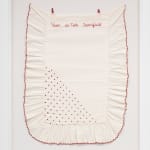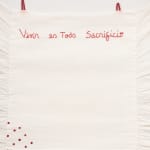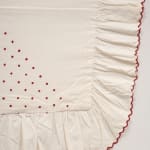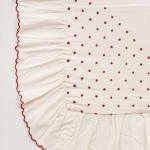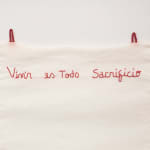Feliciano Centurión
Vivir es Todo Sacrificio [To live is to sacrifice], 1996
Embroidery with inclusion on blanket
55 x 43 cms
21 5/8 x 16 7/8 inches
21 5/8 x 16 7/8 inches
Further images
'Vivir es Todo Sacrificio’ demonstrates Centurión’s appropriation of materials traditionally associated with the feminine and domestic to create new meanings. The work is minimal in its execution with Centurión’s embroidered...
'Vivir es Todo Sacrificio’ demonstrates Centurión’s appropriation of materials traditionally associated with the feminine and domestic to create new meanings. The work is minimal in its execution with Centurión’s embroidered words being the only addition to the blanket. But the junction of the textile, with its symbolic power and the embroidered aphorism - catholic in its undertones - creates a work laden with experience, power and beauty. Created during the last year of the artist’s life the red embroidery cannot but speak to the pain and suffering of HIV/AIDS. Whilst the work’s titular aphorism is a demonstration of the calm acceptance with which Centurión approached his mortality, the domestic context of the blanket suggests a desire for warmth, protection and for suffering to be soothed.
The Catholic Church has had a sustained impact on sexual and gender politics in Latin America for hundreds of years. In the context of the AIDS epidemic, it is necessary to mention the Church’s historical, doctrinal opposition to sexual education, contraception and homosexuality. There is a potency in Centurión’s embrace of faith in spite of the anti-progressive teachings espoused by some members. His work represented a conscious decision to extract the positive elements of Catholicism and to seek solace towards the end of his life.
The Catholic Church has had a sustained impact on sexual and gender politics in Latin America for hundreds of years. In the context of the AIDS epidemic, it is necessary to mention the Church’s historical, doctrinal opposition to sexual education, contraception and homosexuality. There is a potency in Centurión’s embrace of faith in spite of the anti-progressive teachings espoused by some members. His work represented a conscious decision to extract the positive elements of Catholicism and to seek solace towards the end of his life.
Provenance
Artist's Family EstateExhibitions
Feliciano Centurión: Abrigo at the Americas Society, New York (February 14–May 16, 2020)Affective Affinities - 33rd Biennial of São Paulo, Brazil (7th September - 9th December, 2019)
Literature
2 Art Gallery Shows to Explore From Home, Martha Schwendener, The New York Times, April 15, 2020 https://www.nytimes.com/2020/04/15/arts/design/art-gallery-shows-online.htmlPublications
Iglesias Lukin, Aimé, and Karen Marta. Eds. Feliciano Centurión: Abrigo. p. 89, illustrated. New York: Americas Society, 2020Iglesias Lukin, Aimé, and Karen Marta. Eds. Feliciano Centurión. p. 131, illustrated. New York: Americas Society, 2020
Pérez-Barreiro, Gabriel, and Fabiana Werneck, eds., 33rd Bienal de São Paulo: Affective Affinities: Livro Registro, 165, illustrated. São Paulo: Fundação Bienal de São Paulo, 2018.
Join our mailing list
* denotes required fields
We use cookies on our website to improve your experience. You can find out why by reading our Privacy Policy.
By continuing to browse our site you agree to our use of cookies.
![Feliciano Centurión, Vivir es Todo Sacrificio [To live is to sacrifice], 1996](https://artlogic-res.cloudinary.com/w_1600,h_1600,c_limit,f_auto,fl_lossy,q_auto/artlogicstorage/cbprojects/images/view/9a334957ee7d67e39973e1217a5316c2j.jpg)
![Feliciano Centurión, Vivir es Todo Sacrificio [To live is to sacrifice], 1996](https://artlogic-res.cloudinary.com/w_1600,h_1600,c_limit,f_auto,fl_lossy,q_auto/artlogicstorage/cbprojects/images/view/cddeac2570b311fa8a40338ce50227c9j.jpg)
![Feliciano Centurión, Vivir es Todo Sacrificio [To live is to sacrifice], 1996](https://artlogic-res.cloudinary.com/w_1600,h_1600,c_limit,f_auto,fl_lossy,q_auto/artlogicstorage/cbprojects/images/view/905e73bbaa00092e45b273254f6f856cj.jpg)
![Feliciano Centurión, Vivir es Todo Sacrificio [To live is to sacrifice], 1996](https://artlogic-res.cloudinary.com/w_1600,h_1600,c_limit,f_auto,fl_lossy,q_auto/artlogicstorage/cbprojects/images/view/a91f9edb1d55c3e58868eb7330d35268j.jpg)
![Feliciano Centurión, Vivir es Todo Sacrificio [To live is to sacrifice], 1996](https://artlogic-res.cloudinary.com/w_1600,h_1600,c_limit,f_auto,fl_lossy,q_auto/artlogicstorage/cbprojects/images/view/c02166377adeb0e327df7613042c5e0dj.jpg)
